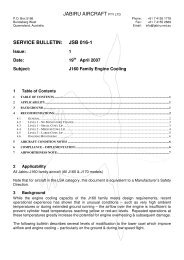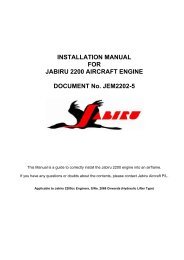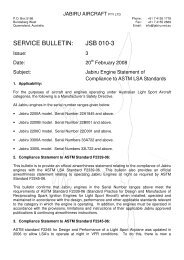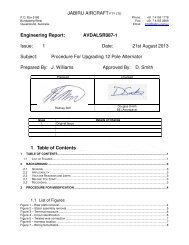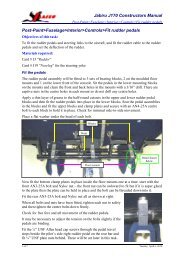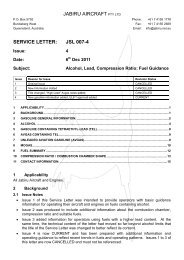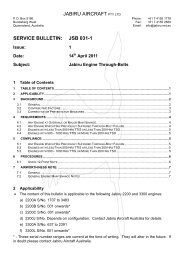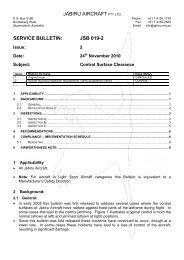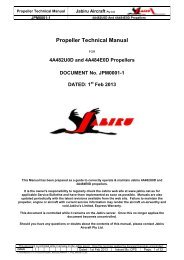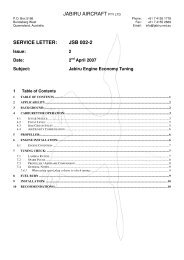INSTRUCTION AND MAINTENANCE MANUAL FOR JABIRU 2200 ...
INSTRUCTION AND MAINTENANCE MANUAL FOR JABIRU 2200 ...
INSTRUCTION AND MAINTENANCE MANUAL FOR JABIRU 2200 ...
Create successful ePaper yourself
Turn your PDF publications into a flip-book with our unique Google optimized e-Paper software.
Jabiru Aircraft Pty LtdInstruction & Maintenance ManualJabiru <strong>2200</strong> Aircraft EngineHydraulic Valve Lifter Models13.2.2 OilUse a non-compounded AVIATION oil:-Aero Shell 100Mobil Red Band (EXXON Aviation Oil 100)BP Aviation Oil 100 Use for 20-25 hours, then drain and replace with a compounded AVIATION oil:-Aero Shell W100Aero Shell 15W50 (for cooler climates)Mobil Aero 100 (SAE 50) (EXXON Aero Elite 100)BP Aero Oil D100/BP Multigrade Aero Oil D SAE 20 W 50Aero Shell W 100 PlusThe normal running oils are detergent and ashless dispersant types. See<strong>MAINTENANCE</strong> SECTION 5.3Oil capacity:The new engine will hold 2.3 litres with an oil cooler.On subsequent oil changes the engine will hold approx 2.2 litres.Do not use any type of automotive oil. Aviation oils have been blended specificallyfor the difficult operating conditions found in an air cooled aero engine operation andusing automotive will be extremely detrimental to its operation.When you change oil from the “run in” type to the “normal” oil at or around 25 hrsreplace oil filter. You may want to cut the filter open for inspection. It is usual in Jabiruengines to find a small amount of aluminium but definitely no metal. If bearing metal ispresent contact the Jabiru Service Department.13.2.3 Engine CoolingAvoid prolonged ground running at elevated RPM. Engine can be over heated duringground operations – remember air ducts are designed for in flight cooling. Groundrunning at high power settings for more than a few minutes requires the use of special,oversize air ducts and oil cooler.Do not apply full power until CHT has reached at least 100°C (212°F)ALWAYS TAKE OFF AT FULL POWER – especially when the engine is new.For the first few take offs climb at a higher airspeed than normal to assist enginecooling. Reduce power at cross wind leg and shallow climb (lower nose).Avoid high nose altitude continual climbs. The higher the climb out speed the better forengine cooling. No low speed high nose altitude climb outs.RETORQUE heads on annual inspection.This document is controlled while it remains on the Jabiru server. Once this no longer applies the document becomes uncontrolled.REVISION 0 1 2 3 4 5 6 7 8 9 Dated : June 2010 Issued By: DPS Page: 106 of 116L:\files\Manuals_For_Products\Engine_Manuals\Transition\JEM2204-9_I&M_unsigned.docx





